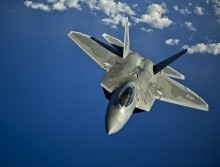The deployment of advanced American fighterjets to the Middle East certainly caught Iran’s attention. But the location of the F-22s, in the United Arab Emirates, raises questions as to why the US sent them. And was it a message being sent to Iran, or someone else?
The United States—as a member of the P5+1—has recently re-launched negotiations with Iran over Tehran’s nuclear program. Those talks are set to continue on May 23.
The US has made the discussions a significant matter, especially with the threat of a military strike on Iran to halt their nuclear program looming in the air. The US needs Iran to make some concessions in the talks soon in order to delay or prevent a regional war.
The Iranians have been making more and more progress in their nuclear program, and they have begun moving nuclear fuel enrichment facilities into their underground bunker. That has raised the stakes and shortened the timeline on what to do about Iran’s nuclear ambitions.
The F-22s therefore come at a time of tension, and Iranian comments condemning the arrival of the planes show that they see them as a threat. But the Iranian nuclear program isn’t the only reason why Iran might be troubled by the US fighters.
The placement of the jets in the UAE comes as Iran has been antagonistic towards the UAE over island territory claimed by both. In other words, the F-22s may also be a show of force to dissuade Iran from stepping up their animosity towards the UAE.
Still, the timing of the military deployment with the negotiations on the nuclear program imply that was certainly a message being sent. A greater military presence from the US doesn’t mean they’re going to war anytime soon, if ever. There are often aircraft carriers in the region that just sit there. But it did get attention. For now, I’d expect that was all it was intended to do.
At the same time, Iran isn’t the only nation who received a message from this. It wasn’t coincidence that Israeli President Shimon Peres expressed confidence in US President Barack Obama not long after the F-22 story broke. While it remains to be seen if Peres’ peace of mind was just good statesmanship (a high-ranking US senator was there at the time) or if Peres speaks for the entire government, it nonetheless caught Israel’s attention too.
It’s essential that the US and Israel end up on the same page on this matter. Israel is the one facing the greatest immediate threat from Iranian nukes, so their intel should be given extra credibility. Meanwhile, the US will undoubtedly get drawn into a conflict whether they start it or not, at the very least diplomatically. Hence their concerns need to be considered as well.
So for now, the US is sending a message of strength—warning Iran and reassuring Israel. And they aren’t the only one talking.
The Germans, another member of the P5+1 in talks with Iran, officially transferred the fourth Dolphin-class submarine to Israeli control last Thursday. That sub is due to arrive in Israel in 2013, according to an Israeli Defense Ministry press release.
Like the F-22s, which are likely not intended as an immediate threat, the sub ceremony was more for publicity and rhetoric than military planning. The timeframe is just too far out at this point.
Nonetheless, the message was sent: The West is supporting Israel and isn’t afraid to saber-rattle a little. Iran better take note that the upcoming nuclear talks aren’t just to talk.
That’s the message here. Now it’s up to the West to be tough on May 23 to ensure Iran doesn’t get mixed signals.
(By Joshua Spurlock, www.themideastupdate.com, May 5, 2012)

